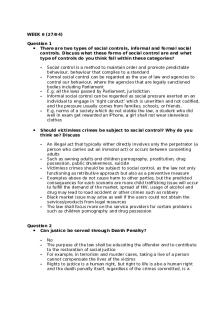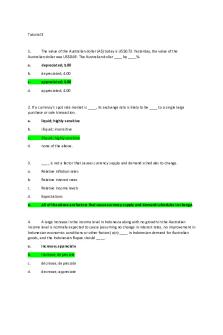Tutorial 3 Tutor Guide PDF

| Title | Tutorial 3 Tutor Guide |
|---|---|
| Author | Zac Grosbard |
| Course | Specialties 1 |
| Institution | University of Queensland |
| Pages | 2 |
| File Size | 93.4 KB |
| File Type | |
| Total Downloads | 100 |
| Total Views | 144 |
Summary
Download Tutorial 3 Tutor Guide PDF
Description
Session Name:
On the day of the OSCEs
Session Aim:
Introduce how the day of the OSCEs assessment will run for students and familiarise students with some additional example stations. Use your own varied and extensive experience with OSCEs to value add to the proposed lesson content below. This lesson plan is provided as a guide for how to run your tutorial, but feel at liberty to adapt it in a way that feels appropriate to your own style!
Pre-session activities:
None
Background reading:
None
Resources for the session:
Example stations (including instructions for candidates/examiner, mark sheets, expected answers) Answers for each station are present in the mark sheet for each station
Session Plan Timing
Content/Objective
Introductions
Establish rapport and engagement Explain what will be covered in the session Field questions that students have had since last week
What is OSCE day like?
Basic Information Allowed resources (pen/paper/watch?/stethoscope/student ID card) Dress code - hospital attire, closed toed shoes Standard station setup (what is provided?) Clipboard and paper Timer Copy of the task sheet and (if relevant), investigation findings, exam findings, etc. Materials needed to complete the station (e.g., necessary exam tools Snellen chart, tuning fork) Time of arrival (as indicated by email from UQ) does not indicate the time you will actually commence the assessment; you could be waiting for hour(s) Arrival at Testing Facility/Holding Area ● Disallowed materials (e.g., no electronic devices including smart watches); backpacks/purses are stored away for the duration of the day until released ● Allows materials (e.g., printed notes, books, board games, etc.) ● Allocation to a testing group ○ 10 students led to examination facility (outpatients clinic, CBL rooms) ○ Bells prompt you to commence reading time, commence the station, and move to the next ○ Arrows on the walls tell you the direction of stations; rooms are usually right next to each other ● Station ○ 2 minutes reading + 8 minutes to complete the station ○ Number of people in the room varies from 1-4 ○ Notes taken for that station are handed to the examiner/patient at the completion of each; materials are not taken from the room Completion of OSCEs ● Returned to a separate holding room with the other students who have completed the assessment ● Still no access to electronic devices ● Wait to be released until the last group is sitting in the holding rooms/taking the examination ● Will take weeks-months to receive the results of the OSCEs; don’t fret
Station 1
Summary: Consent for appendicectomy surgery. Recommendation: Use QHealth standardised consent form to talk through the criteria for informed consent (this form will usually not be provided in the station itself).
Key principles: Once again, clinical communication is the focus rather than clinical knowledge Students should familiarise themselves with the standard criteria for informed consent as per the QHealth form Very common skill to observe and practice on GenSurg Station 2
Summary: Assessing suicide risk in depression. Assessment criteria document provides some additional history of the patient. Recommendation: Work through the first task however you feel appropriate. The second task is a good opportunity to help students work on ISBAR. Ask one student to present the patient, provide feedback, then ask another student to try the same thing until you and the group settle on a handover that you all agree is satisfactory. Key principles: Introduce an appropriate framework for students to assess risk, e.g. dynamic and static risk factors or the 4 Ps (predisposing, precipitating, perpetuating, protective factors) Revise ISBAR format for handover/presentation of patients Highlight the importance of safety. Marking sheet specifically mentions considering admission and escalating to a supervising doctor as appropriate management.
Station 3
Summary: OCP Counselling Recommendation: Try to keep students very focused in their histories and exams. Avoid “spray-and-pray” history taking. Highlight the limited time allocated to hx taking, and the need to keep things very concise. Key principles: Re-emphasise the importance of having a structure, in this case basing the additional history and examination off the absolute and relative contraindications of the OCP
Question time
Take questions and make note of frequently-asked questions so you can feed them back to the project team :)
Next Session Topic
Further example stations with tips and tricks
Post-session activities:
Post-Session Feedback form (both students and tutors)...
Similar Free PDFs

Tutorial 3 Tutor Guide
- 2 Pages

Tutorial 1 and 2 Tutor
- 7 Pages

Momentum tutor 3
- 6 Pages

tutor sql
- 17 Pages

Tutoraggio - Tutor
- 7 Pages

Tutor notes
- 5 Pages

Tutorial 3
- 3 Pages

Tutorial 3
- 4 Pages

Tutorial 3
- 4 Pages

Tutorial 3
- 12 Pages

3 - tutorial
- 6 Pages

Tutorial 3
- 6 Pages

Tutorial 3
- 4 Pages

Tma01 - tutor marked assignments
- 3 Pages

Tutorial question answer guide
- 3 Pages

Tutorial 3 - Lecture notes 3
- 5 Pages
Popular Institutions
- Tinajero National High School - Annex
- Politeknik Caltex Riau
- Yokohama City University
- SGT University
- University of Al-Qadisiyah
- Divine Word College of Vigan
- Techniek College Rotterdam
- Universidade de Santiago
- Universiti Teknologi MARA Cawangan Johor Kampus Pasir Gudang
- Poltekkes Kemenkes Yogyakarta
- Baguio City National High School
- Colegio san marcos
- preparatoria uno
- Centro de Bachillerato Tecnológico Industrial y de Servicios No. 107
- Dalian Maritime University
- Quang Trung Secondary School
- Colegio Tecnológico en Informática
- Corporación Regional de Educación Superior
- Grupo CEDVA
- Dar Al Uloom University
- Centro de Estudios Preuniversitarios de la Universidad Nacional de Ingeniería
- 上智大学
- Aakash International School, Nuna Majara
- San Felipe Neri Catholic School
- Kang Chiao International School - New Taipei City
- Misamis Occidental National High School
- Institución Educativa Escuela Normal Juan Ladrilleros
- Kolehiyo ng Pantukan
- Batanes State College
- Instituto Continental
- Sekolah Menengah Kejuruan Kesehatan Kaltara (Tarakan)
- Colegio de La Inmaculada Concepcion - Cebu